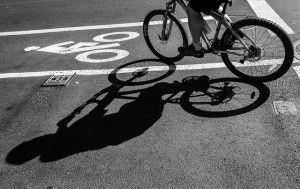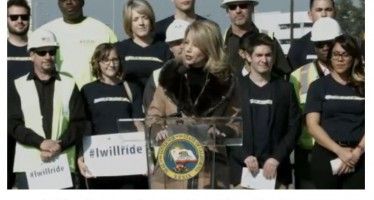Caltrans greenlights bike lane expansion
 Bending to legislative prodding from Sacramento, California’s transportation bureaucracy has moved ahead with statewide plans to standardize and expand the Golden State’s bike lanes.
Bending to legislative prodding from Sacramento, California’s transportation bureaucracy has moved ahead with statewide plans to standardize and expand the Golden State’s bike lanes.
Despite persistent criticism from bike-friendly advocacy groups like the Green Lane Project, Caltrans opted against such sweeping measures. In 2014, however, Democratic officials decided to change that:
“Last year, the state’s legislature passed the Protected Bikeways Act of 2014, removing the de facto blockage and telling Caltrans to create statewide standards for protected bike lanes. Now, with the support of Gov. Jerry Brown and Caltrans Director Malcolm Dougherty, the agency is following through with such enthusiasm that it’s drawing praise from bikeway design pros.”
When Gov. Brown signed the bill into law, supporters hailed the move as a giant leap in mainstreaming bicycle usage statewide. “This is a game changer for bike infrastructure in California,” said Assemblyman Phil Ting, D-San Francisco, the bill’s sponsor. “Sharing the road is one thing but designing it better is another thing altogether. By changing our streets, cycling can finally become a realistic transportation option for millions of Californians held back by safety concerns.”
For decades, the expansion of bike lanes has been a project most closely associated in California with Democrats. In addition to making the roads more accessible for mobile nature lovers, bike lanes have long been touted as a way to help decrease reliance on cars — reducing their environmental impact while also likely habituating residents to more often consider using public transportation.
But recently, some Democrat-sponsored initiatives have inspired some head-scratching. In the Assembly, Kansen Chu, D-San Jose, had to take AB 28 back to the drawing board when critics questioned its requirement that cyclists utilize a flashing white light during nighttime hours.
Republican innovation
Typically, Republican interest in bike lane issues has been thought of as largely car-centric. Recently, for instance, Assemblyman Frank Bigelow, R-O’Neals, drafted AB 208, a bill designed to help alleviate driver uncertainty about how to pass cyclists safely.
But in a surprise offering, Assemblywoman Kristin Olsen, R-Modesto, recently unveiled a plan to expand the modes of transportation eligible for bike lane usage. Soon to receive a committee hearing, AB 604 would authorize stakeboarders with electric motors to ride anywhere bicycles are permitted.
“Electrically-motorized skateboards are a safe and eco-friendly mode of transportation for commuters,” Olsen said in a statement posted to her website, “yet current law bans them from being ridden in California.”
“The ban was implemented in 1977 to keep noisy, gas-powered boards off the streets, but boards built today are quiet, clean and safe to ride. Despite the restriction, manufacturers of these boards continue to invest in our state by developing and building their products here. The industry is growing world-wide – so it’s time to modernize California law to support this emerging technology.”
Although manufacturers of electrically-powered skateboards quickly voiced their favor, according to Capital Public Radio, cyclists groups seemed ready to consider embracing their would-be fellow travelers. “The California Bicycle Coalition says it wants to ensure bike lanes don’t get too crowded,” CPR reported, “but other than that, it likes the idea.”
Scattered opposition
The popularity of bike lanes — and the push among legislators to promote their use — has been traced back to California roots in the city of Davis. There, in the mid-1960s, city council leaders and University of California-Davis professors created a coalition able to design, approve, and implement a network of lanes now totaling some 150 miles’ worth.
Today, however, bike lanes still haven’t secured unanimous support. “The expansion of bike lanes in Los Angeles can make motorists feel a bit elbowed out,” noted the LA Weekly. “We’ve seen perfectly pristine four-lane roads transformed into two-laners with thick strips of asphalt set aside just for the peddle-power set.” In addition to complaints from motorists, some have voiced more specific objections. “The only people who can use bike lanes are able-bodied and physically fit,” one reader wrote to the Los Angeles Daily News.
Related Articles
More furloughs, but no budget
JULY 29, 2010 By KATY GRIMES Faced with a $19.1 billion state deficit and no acceptable budget in the works,
Nancy Pelosi will vote for legal pot
Although former House Speaker Nancy Pelosi, D-San Francisco, waited until the last minute, she sent an unequivocal message to
Ground broken on troubled high-speed rail project
Yesterday in Fresno the California High-Speed Rail Authority officially conducted the groundbreaking ceremony for its bullet-train project – but




